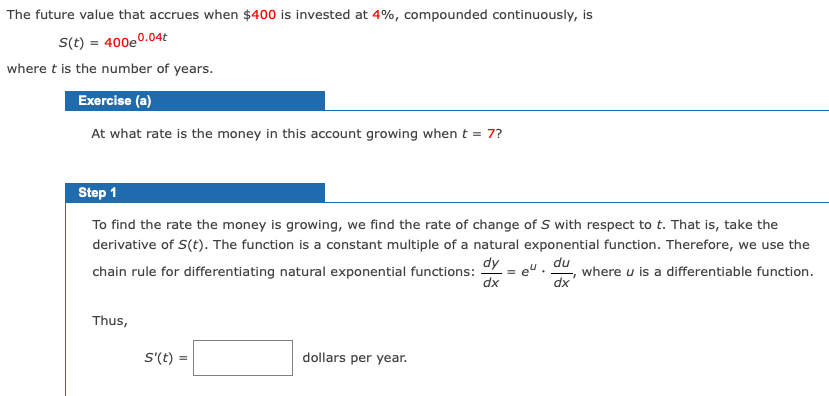The future value that accrues when $400 is invested at 4%, compounded continuously, is S(t) = 400e0.04t where t is the number of years. Exercise (a) At what rate is the money in this account growing when t = 7?
The future value that accrues when $400 is invested at 4%, compounded continuously, is S(t) = 400e0.04t where t is the number of years. Exercise (a) At what rate is the money in this account growing when t = 7?
Chapter6: Exponential And Logarithmic Functions
Section6.1: Exponential Functions
Problem 60SE: The formula for the amount A in an investmentaccount with a nominal interest rate r at any timet is...
Related questions
Question

Transcribed Image Text:The future value that accrues when $400 is invested at 4%, compounded continuously, is
S(t) = 400eº
0.04t
where t is the number of years.
Exercise (a)
At what rate is the money in this account growing when t = 7?
Step 1
To find the rate the money is growing, we find the rate of change of S with respect to t. That is, take the
derivative of S(t). The function is a constant multiple of a natural exponential function. Therefore, we use the
dy
chain rule for differentiating natural exponential functions:
du
where u is a differentiable function.
dx
eu.
xp
Thus,
S'(t):
dollars per year.

Transcribed Image Text:The rate at which the money is growing is expressed by the derivative of the function, which we found in part
(a).
S'(t) = 16e0.04t
Use the derivative to find the rate of change evaluated at t = 13 years.
0.04
= 16e
S'(13)
Expert Solution
This question has been solved!
Explore an expertly crafted, step-by-step solution for a thorough understanding of key concepts.
This is a popular solution!
Trending now
This is a popular solution!
Step by step
Solved in 2 steps with 1 images

Knowledge Booster
Learn more about
Need a deep-dive on the concept behind this application? Look no further. Learn more about this topic, calculus and related others by exploring similar questions and additional content below.Recommended textbooks for you


Algebra and Trigonometry (MindTap Course List)
Algebra
ISBN:
9781305071742
Author:
James Stewart, Lothar Redlin, Saleem Watson
Publisher:
Cengage Learning

Linear Algebra: A Modern Introduction
Algebra
ISBN:
9781285463247
Author:
David Poole
Publisher:
Cengage Learning


Algebra and Trigonometry (MindTap Course List)
Algebra
ISBN:
9781305071742
Author:
James Stewart, Lothar Redlin, Saleem Watson
Publisher:
Cengage Learning

Linear Algebra: A Modern Introduction
Algebra
ISBN:
9781285463247
Author:
David Poole
Publisher:
Cengage Learning

Algebra & Trigonometry with Analytic Geometry
Algebra
ISBN:
9781133382119
Author:
Swokowski
Publisher:
Cengage